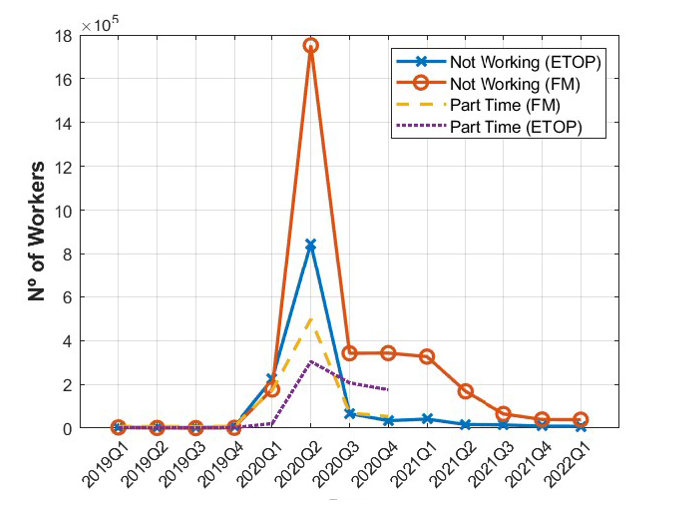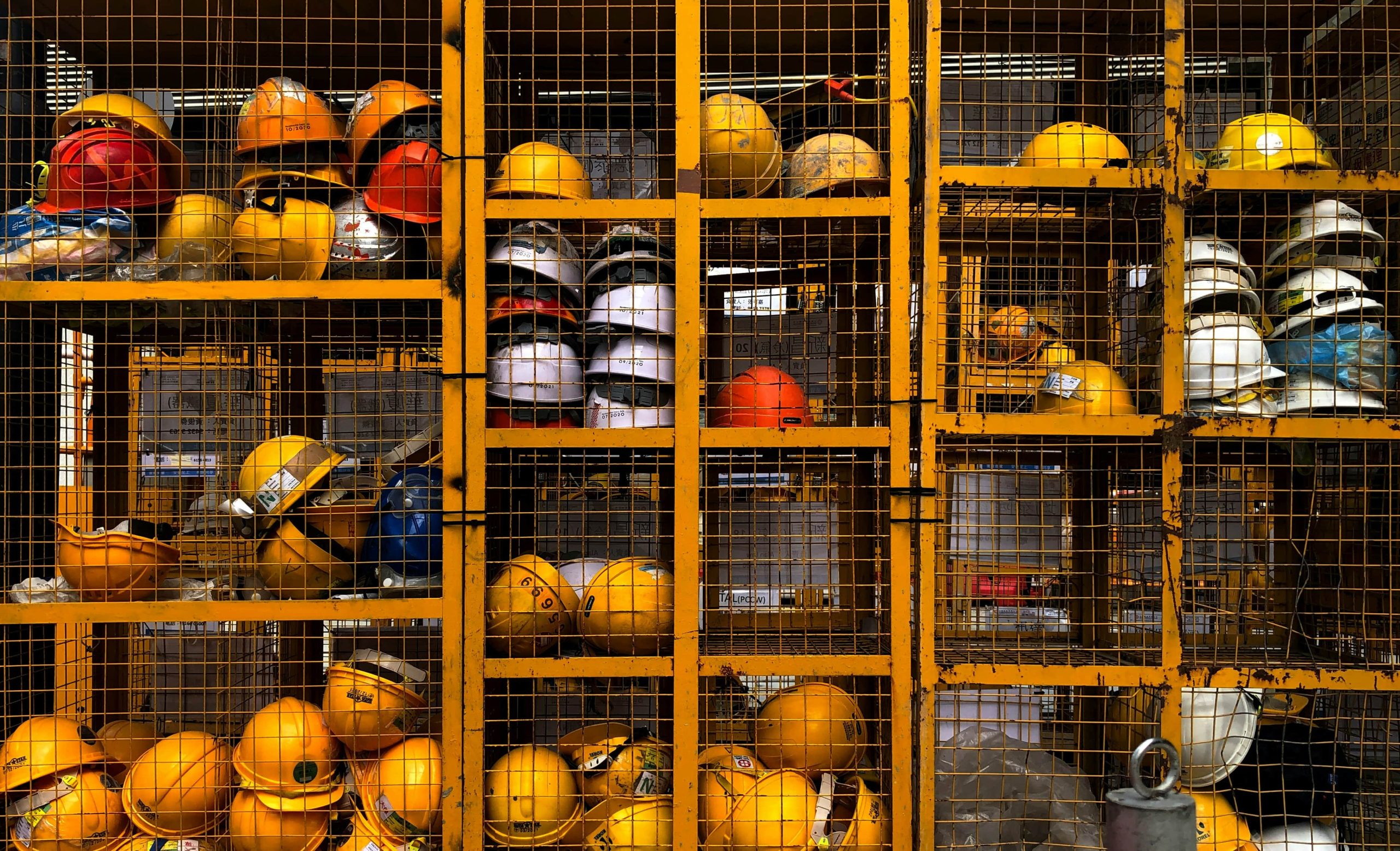Is furlough a win-win policy to fight job losses in recessions?
In response to the Great Recession (GR), several EU countries put several job retention schemes (JR) in place to preserve employment in firms with temporarily weak demand conditions. Among them were short-time work schedules (STW), temporary layoffs, wage subsidies, and work-time accounts. In fact, the idea of protecting jobs during economic downturns has become common economic wisdom among many European countries, resulting in an array of these policies being broadened to include furlough during the Great Contagion (GC, i.e., the COVID-19 pandemic). By establishing a mandatory temporary leave of absence from which employees’ return to work is assured, furlough can be interpreted as an extreme version of STW. In effect, instead of setting a reduced work schedule to avoid the termination of many jobs (intensive margin), furlough reduces working hours directly to zero (extensive margin). It also differs from temporary layoffs in that workers placed on furlough receive much higher social protection during their non-employment spells. In contrast with a large literature on STW and temporary layoffs (see, inter alia, Boeri and Bruecker, 2011; Kopp and Siegentahler, 2021; Gertler et al., 2022; and Giupponi and Landais, 2023), research on the Macroeconomic effects of furlough has been much scarcer so far.
Spain provides an interesting laboratory to understand the effect of furlough for three reasons: (i) unlike their limited use of JR measures during the GR, the Spanish government (with the support of EU-SURE funds) greatly incentivized the use of furlough by firms during the GC through the so-called ERTE (Expedientes de Regulación de Empleo Temporal), (ii) both the GR and the GC share features that speak loud to the impact of furlough schemes, namely, they were driven by sector-specific costs, raising concerns about a slowdown in necessary worker reallocation across sectors, and (iii) its labour market exhibits a large share of vulnerable low-surplus matches due to the prevalence of short-term temporary contracts (TC), which get disproportionally destroyed (i.e., not renewed) in cyclical downturns.
In Díaz et al. (2024), we study these issues relying on detailed information about workers’ trajectories drawn from the Muestra Contínua de Vidas Laborales (MCVL). We leverage regional variations in the industrial composition prior to the two aforementioned recessions to document the employment effects of the sector-specific shocks. Provinces with higher shares of exposed sectors to the respective shocks (mainly hitting construction and ancillary manufacturing industries in the GR, and accommodation, food services, transportation, and other leisure activities during the GC) experienced a disproportionate drop in employment brought about by moderately decreasing job-finding and sharply increasing job-loss rates. Yet, the increase in job-loss rates during the GC has been much less severe than what could have been predicted from the experience of the GR, which already hints at ERTEs being important in explaining those patterns.

Figure 1: Number of employees on ERTE
Indeed, during the GC (Figure 1), we observe a large hike in the number of workers on ERTE, reaching a staggering peak of 24% of all employees by 2020-q2. There are two types of ERTE: (i) ETOP due to economic, technical, and production reasons, and (ii) Force Majeure-FM in sectors affected by lockdown. Apart from a temporary suspension of employment (furlough), firms could still opt for a reduction in working time (STW), though this last option was hardly chosen in practice.
Before turning to the labour market effects of employing this unprecedented job retention program, we need to address why these schemes were hardly used in the GR despite their availability in the Workers Statute since 1980. We argue that two distinctions are important. First, during the GC, the government greatly extended eligibility criteria, simplified the procedure, and drastically reduced payroll taxes for firms with fewer than 50 employees. Second, the much higher persistence of the financial shocks made the adoption of furlough at the time of the burst of the housing bubble much less attractive since the construction sector was oversized (by 2008, the “brick economy” was building 800 thousand dwellings a year, more than France, Germany, and Italy…together). Conversely, it seemed sensible to foster ERTE at the pandemic outbreak in the hope that effective vaccines would be discovered soon.
Turning to their labour market effects, Table 1 provides a first hint that furlough schemes may slow down necessary worker reallocation. That is, overall, few workers on furlough find a job in another firm over a one-year window. Maybe even more surprising, reallocation is particularly low for workers in the heavily affected sectors, for whom the probability of changing employers is 5.3 pp. lower than that of those in the weakly affected sectors.

Table 1: Labour market transitions of workers on ERTE by sectoral exposure
To investigate this reallocation effect, we propose a stylized search and matching model that extends previous models on STW (see, e.g., Balleer et al., 2016, and García-Cabo et al., 2023) by incorporating the main features of ERTE and by allowing for sector-specific shocks and sector-specific human capital, which is partly lost when moving to other sectors. The main ingredients of this model are (i) heterogeneous sectors differing in average productivity and size, (ii) workers accumulating sector-specific human capital, which slows down reallocation to other sectors, (iii) aggregate shocks with a strong sector-specific component, and (iv) a large fraction of low-productivity matches to capture the high incidence of TC in the Spanish economy. By calibrating such a model for Spain during each of the two recessions, we are able to investigate both the role of industry concentration in explaining the observed employment dynamics and the potential role of ERTE in facilitating or inhibiting the required reallocation adjustments under that kind of shocks.
Starting with the GC, Figure 2 displays simulations of two alternative scenarios—one without ERTE (counterfactual) and another with ERTE (factual). Consistent with the literature on STW, ERTEs reduced the unemployment rate by 3.7 pp (see Panel (a)). However, many saved jobs would be destroyed once ERTEs end as they were relatively unproductive. We also find that paying the generous ERTE schemes applied in the GC would have reduced unemployment by 3.4 pp. during the GR (recall that the u-rate reached 27% in 2013q1). However, the reduction in the unemployment rate comes at a cost: ERTEs slow down worker reallocation towards the less affected sector mainly through two channels. First, by keeping matches together, workers are overall less likely to search for a different job. Second, by paying relatively high reservation wages (70% of last wages), ERTEs amplify workers’ tendencies to keep searching in the heavily affected sector (see Panel (e)), thus explaining the particularly low job reallocation rates of workers on ERTE in that sector.
Foremost, our model highlights that furlough schemes crowd out endogenous labour hoarding by firms, which in the absence of such policies would continue some temporarily unproductive matches in the hope that future conditions improve (see Panel (b)). Hence, while ERTE reduce unemployment volatility, they increase output volatility since workers on furlough remain idle whereas they still produce something under labour hoarding (see Panel (c)).
Interestingly, as discussed earlier, one may conclude that the widespread use of ERTE during the GC but not in the GR can be rationalized by furlough working relatively better when recessions are shorter. However, this is not necessarily the case. In a short-lived recession, ERTE affect more adversely the working rate, leading to a larger relative drop in aggregate output than in a more prolonged downturn. As explained above, the reason is that firms engage in more labour hoarding absent ERTE in a short recession. In sum, when they are short-lived, ERTE becomes a less valuable tool except to keep the hike in the u-rate under control, as it happened during the GC.
 Figure 2: Aggregate dynamics during the Great Contagion
Figure 2: Aggregate dynamics during the Great Contagion
Taken together, we caution in judging the success of ERTEs by simply looking at the volatility of the unemployment rate. Particularly in the case of Spain, making ERTEs almost free to many firms implied that a vast majority of low surplus matches were temporarily kept together. As reforming these matches anew is not particularly costly, the gains may not be particularly large. Instead, we argue that the costs (beyond the fiscal ones) are likely to be large: worker reallocation slows down, and firms reduce endogenous labour hoarding. To favour ERTE as in the 2021 labour market reform, one needs a rationale for firms to destroy high-surplus marches in the absence of such a scheme. Financial frictions are one possible reason not explicitly incorporated in our model. Yet, if this type of friction is the root cause, it is not clear why governments do not target them directly instead of subsidizing match preservation in jobs that are not likely to survive. Indeed, the so-called ICO-Guarantee Line was put into action by 2020, implying that banks could grant a loan to SMEs and the self-employed (114,000 million euros in 2020) so that 80% was guaranteed by the State. Since ERTE has become an important ingredient of the 2021 labour market reform to cushion sectoral and aggregate shocks in the future, the previous results call for more incentives to workers searching for jobs in different sectors and a faster pace in the reduction of firm subsidies in declining industries.
Further Reading:
Díaz, Antonia, Dolado, Juan J., Jáñez, Álvaro, and Felix Wellschmied. 2024. “Labor Reallocation Effects of Furlough Schemes: Evidence from Two Recessions in Spain” https://www.eco.uc3m.es/~fwellsch/docs/reg_sec_spec.pdf
About the authors:
Antonia Díaz is Full Professor at the Economics Department of Universidad Complutense de Madrid. She works on Macroeconomics and Environmental Economics.
https://sites.google.com/site/antoniadiazwebsite/home
Juan J Dolado is Honorary Professor at the Economics Department of Universidad Carlos III de Madrid. He works on Econometric Theory, Labour Economics, and Macroeconomics.
https://dolado.blogspot.com/
Álvaro Jáñez is a Ph.D. student at the Economics Department of Universidad Carlos III de Madrid. He will joining the Stockholm School of Economics as AP later this year. He works on Labour Economics, and Macroeconomics.
https://ajanez.github.io/
Felix Wellschmied is Associate Professor at the Economics Department of Universidad Carlos III de Madrid. He works on Labour Economics, and Macroeconomics.
https://www.eco.uc3m.es/~fwellsch/research.html
References:
Balleer, A., Gehrke, B., Lechthaler, W., and Merkl, C. (2016). Does short-time work save jobs? A business cycle analysis. European Economic Review, 84:99–122.
Boeri, T. and Bruecker, H. (2011). Short-time work benefits revisited: some lessons from the Great Recession. Economic Policy, 26(68):697–765.
García-Cabo, J., Lipinska, A., and Navarro, G. (2023). Sectoral shocks, reallocation, and labor market policies. European Economic Review, page 104494.
Gertler, M., Huckfeldt, C. K., and Trigari, A. (2022). Temporary layoffs, loss-of-recall and cyclical unemployment dynamics. Technical report, National Bureau of Economic Research.
Giupponi, G. and Landais, C. (2023). Subsidizing labour hoarding in recessions: The employment and welfare effects of short-time work. The Review of Economic Studies, 90(4):1963–2005.
Kopp, D. and Siegenthaler, M. (2021). Short-time work and unemployment in and after the Great Recession. Journal of the European Economic Association, 19(4):2283–2321.



